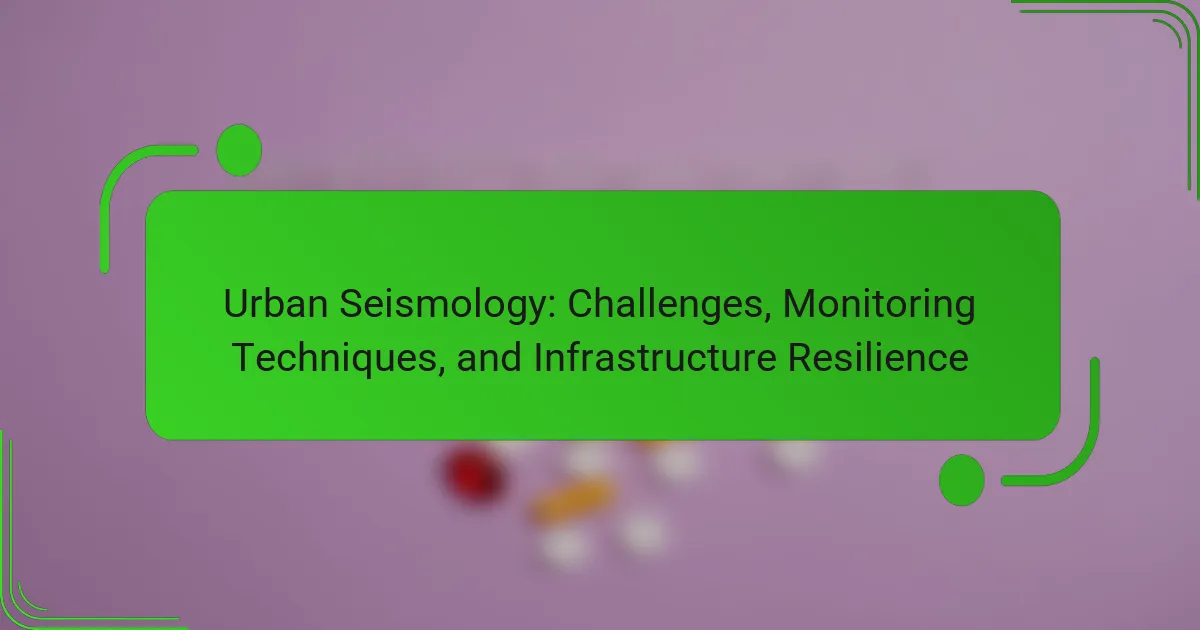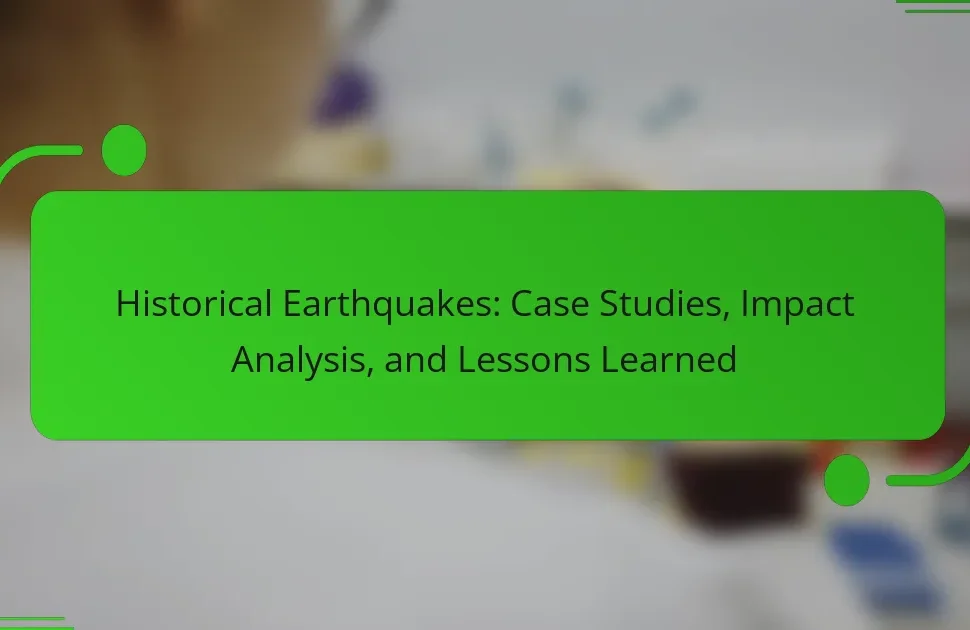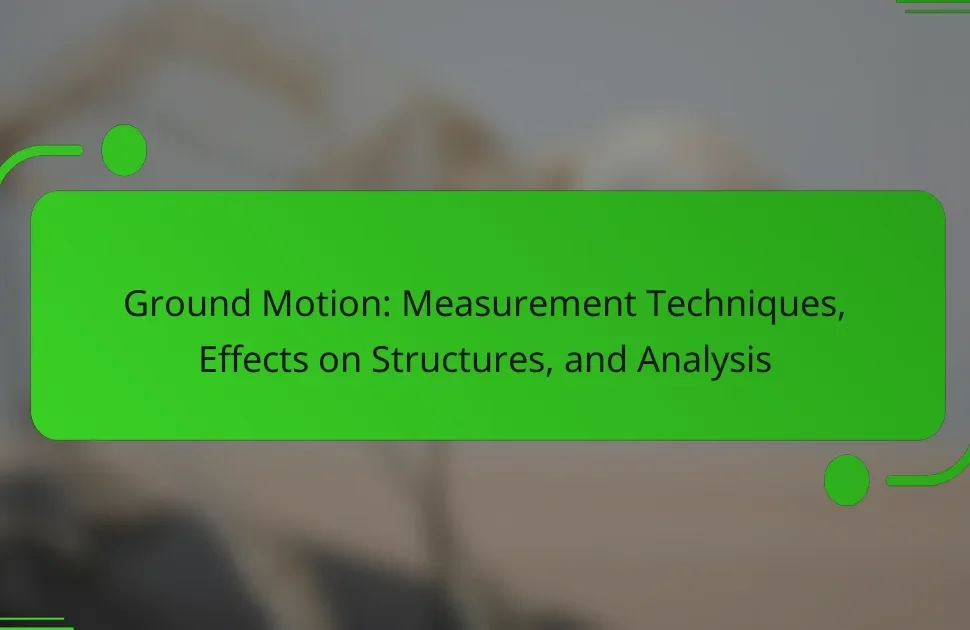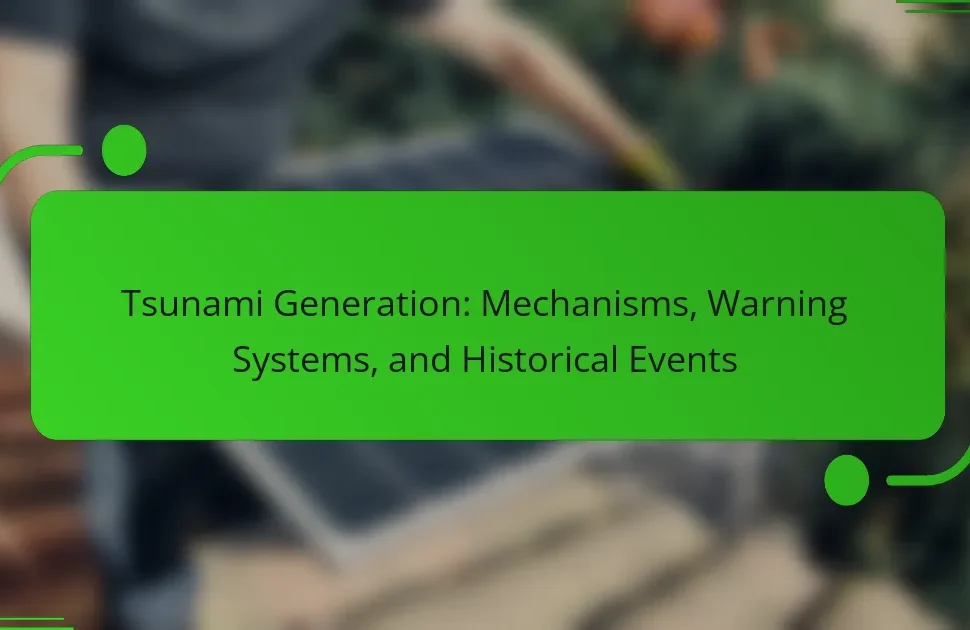Urban seismology is the study of seismic activity within cities, focusing on the impact of earthquakes on urban infrastructure. This field analyzes ground motion, building responses, and potential hazards, integrating data from seismic networks with urban planning to enhance earthquake preparedness. The article explores the challenges faced in urban seismology, advanced monitoring techniques employed to assess risks in densely populated areas, and strategies to improve infrastructure resilience against seismic events. By emphasizing effective urban seismology practices, the article highlights the importance of minimizing damage and ensuring public safety during earthquakes.

What is Urban Seismology?
Urban seismology is the study of seismic activity in urban areas. It focuses on understanding how earthquakes affect cities and their infrastructure. This field examines ground motion, building response, and potential hazards. Urban seismology integrates data from seismic networks with urban planning. It aims to improve earthquake preparedness and response strategies. Researchers utilize advanced monitoring techniques to assess risks in densely populated regions. Effective urban seismology can enhance infrastructure resilience against seismic events. This approach is crucial for minimizing damage and ensuring public safety during earthquakes.
How does Urban Seismology differ from traditional seismology?
Urban seismology focuses on the seismic behavior of urban environments, while traditional seismology studies earthquakes and seismic waves in general. Urban seismology emphasizes the impact of buildings and infrastructure on seismic response. It utilizes dense sensor networks to monitor ground motion in populated areas. Traditional seismology often relies on sparse seismic stations for data collection. Urban seismology addresses the unique challenges posed by urbanization, such as soil-structure interaction. In contrast, traditional seismology typically does not consider these urban-specific factors. Urban seismology aims to enhance resilience and safety in cities during seismic events. Traditional seismology primarily focuses on understanding earthquake mechanisms and predicting seismic hazards.
What are the key components of Urban Seismology?
The key components of Urban Seismology include seismic hazard assessment, ground motion monitoring, and structural response evaluation. Seismic hazard assessment identifies potential earthquake risks in urban areas. Ground motion monitoring involves using sensors to measure seismic activity in real-time. Structural response evaluation examines how buildings and infrastructure react to seismic forces. These components work together to improve urban resilience against earthquakes. Research indicates that effective urban seismology can significantly reduce damage and enhance safety during seismic events.
Why is Urban Seismology important for city planning?
Urban Seismology is crucial for city planning because it helps assess seismic risks in urban environments. Understanding local geological conditions allows planners to design safer buildings and infrastructure. Seismic data informs the development of building codes and land-use policies. This ensures structures can withstand earthquakes, minimizing damage and loss of life. Studies show that cities with robust seismic planning have significantly lower economic losses during earthquakes. For instance, the 2010 Haiti earthquake highlighted the consequences of inadequate urban planning in seismically active areas. By integrating Urban Seismology into city planning, municipalities can enhance resilience and preparedness against seismic events.
What challenges does Urban Seismology face?
Urban seismology faces several challenges. One major challenge is the complexity of urban environments. Buildings and infrastructure can distort seismic waves, complicating data interpretation. Another challenge is the need for dense sensor networks. Urban areas require more sensors to capture detailed seismic activity. Additionally, funding and resource allocation can be limited. Many urban seismology projects struggle with insufficient financial support. There is also the challenge of public awareness and preparedness. Many residents may not understand seismic risks or how to respond. Finally, integrating data from different sources can be difficult. Coordination among various agencies and organizations is often required for effective monitoring.
How do urban environments complicate seismic monitoring?
Urban environments complicate seismic monitoring due to structural interference and noise pollution. Buildings and infrastructure can obstruct seismic waves, leading to inaccurate readings. Urban areas often experience higher levels of background noise from traffic and construction. This noise can mask seismic signals, making it difficult to detect smaller earthquakes. Additionally, the complex geology beneath cities can alter seismic wave propagation. Variations in soil types and human-made structures affect how waves travel. These factors collectively hinder the effectiveness of traditional seismic monitoring techniques.
What are the limitations of current seismic data in urban areas?
Current seismic data in urban areas has several limitations. One major limitation is the dense infrastructure, which can obstruct seismic wave propagation. This results in incomplete data and reduced accuracy in detecting seismic events. Another limitation is the variability in soil types across urban settings. Different soil conditions can alter seismic wave speeds and lead to misinterpretations. Additionally, existing seismic networks may lack sufficient density in urban regions. This can result in gaps in data coverage and hinder effective monitoring. Furthermore, urban noise from traffic and construction can interfere with seismic signals. This noise pollution complicates the identification of genuine seismic events. Lastly, current seismic models may not adequately account for urban complexities. This can lead to underestimations of potential seismic risks in densely populated areas.
What role does technology play in Urban Seismology?
Technology plays a crucial role in Urban Seismology by enhancing monitoring and data analysis capabilities. It enables real-time seismic data collection through advanced sensors and networks. These sensors improve the accuracy of earthquake detection and location. Technologies such as Geographic Information Systems (GIS) aid in visualizing seismic hazards in urban areas. Moreover, machine learning algorithms analyze seismic data for better prediction models. The integration of mobile applications allows for public alerts and information dissemination during seismic events. These technological advancements contribute to improved infrastructure resilience and disaster preparedness in urban settings.
What are the latest monitoring techniques used in Urban Seismology?
The latest monitoring techniques used in Urban Seismology include dense networks of seismic sensors, real-time data processing, and advanced machine learning algorithms. Dense networks enhance spatial resolution and provide detailed seismic activity data. Real-time data processing allows for immediate analysis of seismic events. Machine learning algorithms improve the accuracy of earthquake detection and damage assessment. These techniques enable faster response times and better-informed urban planning. Recent studies, such as those conducted by the USGS, highlight the effectiveness of these methods in urban environments.
How do these technologies enhance data accuracy?
Technologies enhance data accuracy in urban seismology by utilizing advanced sensors and algorithms. High-precision sensors capture seismic waves with greater fidelity. These sensors can detect minute vibrations, allowing for detailed analysis of seismic events. Algorithms process this data to filter noise and improve signal clarity. Machine learning techniques further refine data interpretation, identifying patterns and anomalies. Real-time data transmission ensures timely updates and reduces the risk of data loss. Collectively, these advancements lead to more reliable seismic assessments. Studies show that improved sensor networks can increase detection rates by up to 30%.
How can infrastructure resilience be improved in urban areas?
Infrastructure resilience in urban areas can be improved through strategic planning and investment. Enhancing building codes is essential to ensure structures withstand natural disasters. Regular maintenance of existing infrastructure reduces vulnerability to failures. Incorporating green infrastructure, such as permeable pavements, can mitigate flooding risks. Implementing advanced monitoring technologies allows for real-time assessments of structural integrity. Community engagement in resilience planning fosters local support and awareness. Finally, integrating climate change projections into urban planning ensures adaptability to future conditions. These strategies collectively strengthen urban infrastructure against various hazards.
What strategies are effective for enhancing infrastructure resilience?
Effective strategies for enhancing infrastructure resilience include adopting robust design standards, implementing regular maintenance, and utilizing advanced monitoring technologies. Robust design standards ensure structures can withstand extreme events. Regular maintenance prevents deterioration and identifies vulnerabilities early. Advanced monitoring technologies, such as real-time sensors, provide data on structural performance. Integrating these strategies can significantly reduce damage during seismic events. Research indicates that cities implementing these strategies have lower recovery costs post-disaster. For example, the 2011 earthquake in Japan highlighted the effectiveness of resilient infrastructure in minimizing damage and ensuring quicker recovery.
How can Urban Seismology inform infrastructure design?
Urban Seismology can inform infrastructure design by providing critical data on seismic risks. This field studies the impact of earthquakes on urban environments. It helps engineers understand ground motion patterns. Such knowledge aids in designing buildings that can withstand seismic forces. For instance, cities like San Francisco utilize seismic hazard maps. These maps highlight areas at higher risk for earthquakes. Engineers use this information to select appropriate materials and design techniques. Research shows that structures designed with seismic data in mind perform better during earthquakes. This ultimately enhances public safety and reduces economic losses.
What are the implications of Urban Seismology for disaster preparedness?
Urban Seismology significantly enhances disaster preparedness by providing critical data on seismic hazards in urban areas. It allows for the identification of vulnerable structures and populations within cities. This field employs advanced monitoring techniques, such as seismic sensors and data analysis, to assess earthquake risks. Accurate seismic hazard assessments inform urban planning and building codes. Historical data from past earthquakes guide the development of effective emergency response strategies. Furthermore, community education on seismic risks fosters resilience among residents. Research indicates that cities with robust urban seismology frameworks experience reduced damage during seismic events. For example, cities like Los Angeles have implemented early warning systems that save lives and minimize economic losses.
How can cities use seismic data for emergency response planning?
Cities can use seismic data to enhance emergency response planning by analyzing earthquake patterns and potential impacts. This data helps identify high-risk areas that may experience significant shaking. Cities can develop evacuation plans based on these risk assessments. Real-time seismic data allows for timely alerts to residents during an earthquake. This can minimize panic and improve safety measures. Historical seismic data informs building codes and infrastructure resilience strategies. Cities can prioritize resources and training for emergency responders in areas most likely to be affected. Studies have shown that cities utilizing seismic data have improved their preparedness and response times significantly.
What best practices can urban planners adopt for seismic risk reduction?
Urban planners can adopt several best practices for seismic risk reduction. First, they should implement strict building codes that require earthquake-resistant designs. These codes must be based on local seismic hazard assessments. Second, planners should promote land-use policies that avoid high-density development in high-risk areas. This reduces the potential for significant damage during an earthquake. Third, planners can encourage retrofitting of existing structures to enhance their seismic resilience. Studies show that retrofitting can significantly reduce damage and increase safety. Fourth, urban planners should engage in community education about earthquake preparedness. Educated communities are better equipped to respond effectively during seismic events. Lastly, planners should invest in advanced monitoring systems to track seismic activity. These systems provide real-time data that can inform emergency response strategies.
What future trends are emerging in Urban Seismology?
Emerging trends in Urban Seismology include advancements in real-time monitoring systems. These systems utilize dense sensor networks to improve earthquake detection and response times. Machine learning algorithms are increasingly applied to analyze seismic data for better predictive modeling. Integration of geospatial data enhances urban planning and risk assessment. Additionally, community engagement is becoming vital for effective disaster preparedness. Research indicates a growing focus on resilience-based design in infrastructure. Urban environments are prioritizing adaptive strategies to mitigate seismic risks. These trends reflect a shift towards more proactive and informed approaches in Urban Seismology.
How might advancements in technology shape the future of Urban Seismology?
Advancements in technology will significantly enhance Urban Seismology. Improved sensor networks will allow for real-time data collection. These sensors will provide more accurate measurements of seismic activity. Enhanced data analytics will enable better interpretation of seismic data. Machine learning algorithms can predict seismic events with greater accuracy. Drones and satellite imagery will aid in assessing damage post-event. Geographic Information Systems (GIS) will improve urban planning and risk management. Together, these technologies will lead to more resilient urban infrastructures.
What are the potential impacts of climate change on seismic activity in urban areas?
Climate change may influence seismic activity in urban areas primarily through the alteration of geological and hydrological processes. Increased rainfall and flooding can lead to soil saturation, which may destabilize slopes and trigger landslides. These landslides can cause localized seismic events. Additionally, the melting of glaciers and ice sheets can reduce pressure on tectonic plates, potentially leading to increased seismic activity in some regions. A study published in the journal “Nature” by researchers from the University of Southern California found that changes in groundwater levels due to climate change could affect fault lines and increase the frequency of minor earthquakes. Thus, climate change has the potential to indirectly impact seismic activity through various environmental changes.
What practical steps can cities take to implement Urban Seismology effectively?
Cities can implement Urban Seismology effectively by establishing a comprehensive monitoring network. This network should include seismic sensors strategically placed throughout urban areas. Data collected from these sensors must be analyzed in real-time to assess seismic activity. Cities should also develop public awareness campaigns about seismic risks and safety measures. Collaboration with academic institutions can enhance research and technology in Urban Seismology. Additionally, integrating seismic data into urban planning can improve infrastructure resilience. Regular drills and training for emergency responders are essential for preparedness. These steps are supported by successful implementations in cities like Los Angeles and Tokyo, which have robust seismic monitoring systems in place.
Urban seismology is the study of seismic activity in urban environments, focusing on how earthquakes impact cities and their infrastructures. This article explores the differences between urban and traditional seismology, key components such as seismic hazard assessment and ground motion monitoring, and the role of technology in enhancing data accuracy. It also addresses the challenges urban seismology faces, including urban complexity and limited resources, while highlighting strategies for improving infrastructure resilience and disaster preparedness. Additionally, the article discusses emerging trends and the implications of climate change on seismic activity in urban areas.




